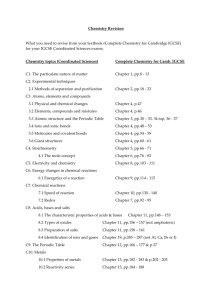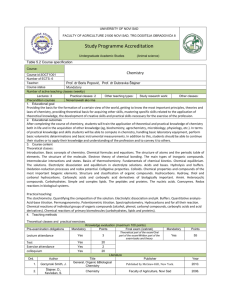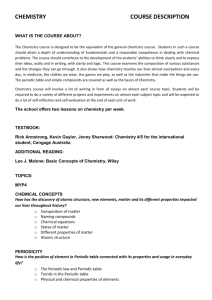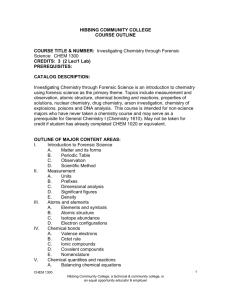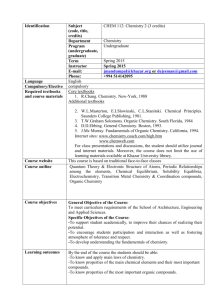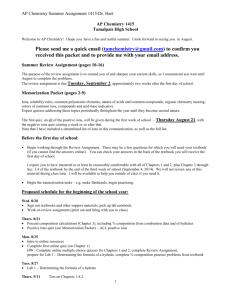Chemistry Level 1 Course Syllabus
advertisement
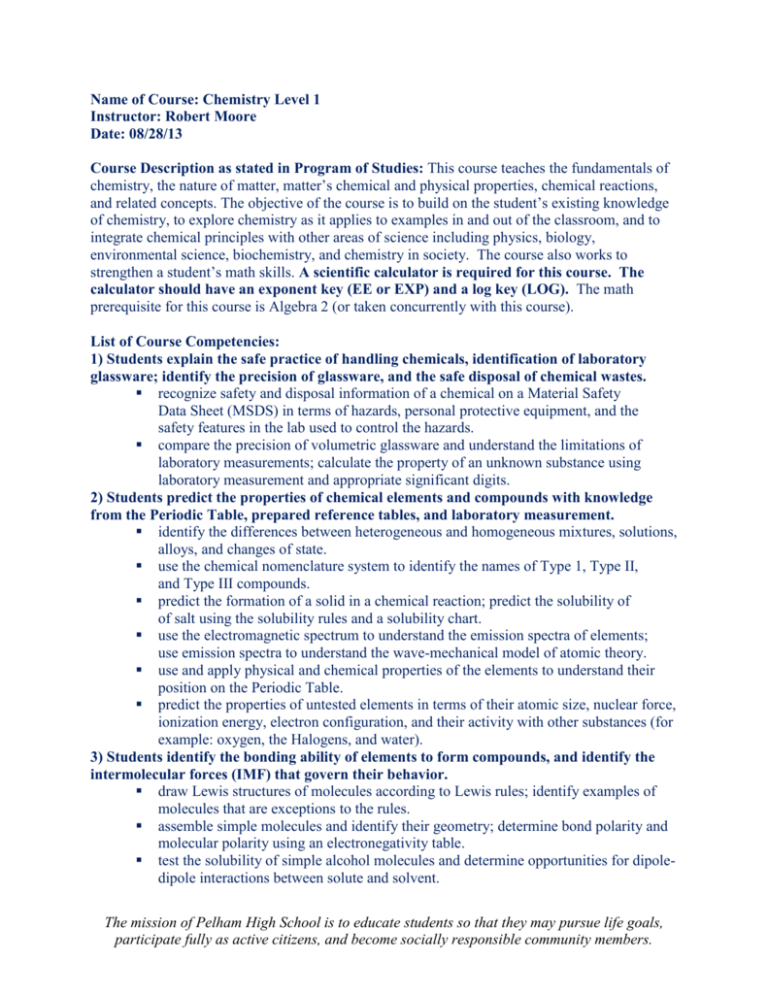
Name of Course: Chemistry Level 1 Instructor: Robert Moore Date: 08/28/13 Course Description as stated in Program of Studies: This course teaches the fundamentals of chemistry, the nature of matter, matter’s chemical and physical properties, chemical reactions, and related concepts. The objective of the course is to build on the student’s existing knowledge of chemistry, to explore chemistry as it applies to examples in and out of the classroom, and to integrate chemical principles with other areas of science including physics, biology, environmental science, biochemistry, and chemistry in society. The course also works to strengthen a student’s math skills. A scientific calculator is required for this course. The calculator should have an exponent key (EE or EXP) and a log key (LOG). The math prerequisite for this course is Algebra 2 (or taken concurrently with this course). List of Course Competencies: 1) Students explain the safe practice of handling chemicals, identification of laboratory glassware; identify the precision of glassware, and the safe disposal of chemical wastes. recognize safety and disposal information of a chemical on a Material Safety Data Sheet (MSDS) in terms of hazards, personal protective equipment, and the safety features in the lab used to control the hazards. compare the precision of volumetric glassware and understand the limitations of laboratory measurements; calculate the property of an unknown substance using laboratory measurement and appropriate significant digits. 2) Students predict the properties of chemical elements and compounds with knowledge from the Periodic Table, prepared reference tables, and laboratory measurement. identify the differences between heterogeneous and homogeneous mixtures, solutions, alloys, and changes of state. use the chemical nomenclature system to identify the names of Type 1, Type II, and Type III compounds. predict the formation of a solid in a chemical reaction; predict the solubility of of salt using the solubility rules and a solubility chart. use the electromagnetic spectrum to understand the emission spectra of elements; use emission spectra to understand the wave-mechanical model of atomic theory. use and apply physical and chemical properties of the elements to understand their position on the Periodic Table. predict the properties of untested elements in terms of their atomic size, nuclear force, ionization energy, electron configuration, and their activity with other substances (for example: oxygen, the Halogens, and water). 3) Students identify the bonding ability of elements to form compounds, and identify the intermolecular forces (IMF) that govern their behavior. draw Lewis structures of molecules according to Lewis rules; identify examples of molecules that are exceptions to the rules. assemble simple molecules and identify their geometry; determine bond polarity and molecular polarity using an electronegativity table. test the solubility of simple alcohol molecules and determine opportunities for dipoledipole interactions between solute and solvent. The mission of Pelham High School is to educate students so that they may pursue life goals, participate fully as active citizens, and become socially responsible community members. determine the boiling point of four organic compounds and after ranking their order, use intermolecular force (IMF) theory to explain their order. based on the polarity of solutes and solvents, discuss why some compounds travel further than others in a chromatography experiment. predict the orbital hybridization of compounds using orbital hybridization theory 4) Students use graphs, charts, and experimental data to determine the rate at which chemical reactions occur. plot potential energy diagrams and determine: ΔH, Ea, A.C., and the effect of a catalyst and an inhibitor on the rate of a reaction. conduct a reaction rate investigation (clock reaction) using time data and calculate the rate constant, k, for the reaction. predict the shift of a chemical equilibrium system when an external stress is placed on the system according to LeChatelier’s principle. discuss how the factors of temperature, surface area, gas pressure, and concentration affect the rate of reaction according to the collision theory. 5) Students use mathematical strategies, the Periodic Table, and reference values to predict measurable quantities in chemical reactions. convert quantities of chemicals from grams to moles to particles to liters of a gas using stoichiometric relationships. solve problems of gases with respect to volume, pressure, temperature, and moles of a gas using appropriate gas laws. determine the molar volume of a gas using Avogadro’s Law, Dalton’s Law of Partial Pressure, and the Combined Gas Law. 6) Students use the concepts of equilibrium, stoichiometry, and solution chemistry to understand acid-base relationships. compare the definition of acids and bases according to Lewis, and Bronsted-Lowry models. use conjugate acid-base pairing to identify the strength of acids and bases and correlate this understanding with acid and base dissociation constants, Ka and Kb. calculate pH problems using logarithmic and anti-logarithmic formulas. prepare a standard acid solution and titrate an unknown base solution to determine its molarity. prepare a chemical buffer system and test the buffer to measure its effectiveness. conduct an acid rain investigation to determine the ability of a simulated lake water to resist a change in pH. determine the Ka value of 6 weak acids and rank the acids ability in order of increasing strength. 7) Students use the concepts of electronegativity and oxidation numbers to predict oxidation-reduction reactions. identify the oxidation numbers of elements and elements in a compound according to redox rules. perform a corrosion study to determine the flow of electrons in a closed circuit balance redox reactions according to the half-reaction method. assemble an electrochemical cell and identify the anode, cathode, electrolyte and direction of electron flow; measure the voltage generated by an electrochemical cell (lemon battery). The mission of Pelham High School is to educate students so that they may pursue life goals, participate fully as active citizens, and become socially responsible community members. 8) School-Wide Expectation for Student Learning Use effective reading, writing, speaking, listening, and viewing skills. Solve authentic problems using technology, mathematical and scientific skills. Behave appropriately and responsibly with regard to others, oneself, and to one’s surroundings. List of Required Texts: Chemistry, Tenth Edition Author: Raymond Chang Resources of Study: Current articles, Internet website addresses, library investigations, laboratory procedures, some from companion laboratory manual (Zumdahl), others from outside sources. Units of Study with Pacing Guide A pacing guide is available upon request. Assessment Activities and Grading 70% of grade: Summative Assessments Oral Presentation Blue Book Tests Lab Reports (non-AP) AP Lab Reports Quizzes 10% of grade: Formative Assessments In class work Homework Class participation Quick writes, writing prompts 20% of grade: Final Exam Class Participation is assessed when students discuss their homework answers with the rest of the class. Students may be asked to show their work on the blackboard or overhead. All students will be encouraged to participate in this process. Long-term assignments are assignments of more than five days in duration. Failure to hand in work by the last acceptable due date will result in a grade reduction of 10% per day. There is an honors option available for this course. An honors contract is available upon request. Honors work is 20% of the final grade. Once the contract is signed, the student is obliged to complete the honors work. The mission of Pelham High School is to educate students so that they may pursue life goals, participate fully as active citizens, and become socially responsible community members. Requirements for Class 1. Students are expected to bring to class: textbook, class notebook, pencil or pen, and when requested a scientific calculator with an EE key and a LOG key. 2. Students are expected to make up work in a timely fashion: one day for each absence. 3. Homework assignments, lab reports, and projects are due on the assigned date. 4. Students are expected to show respect and responsibility during class time. 5. Attendance is very important. The student will be at a distinct disadvantage when a topic is missed – it will be his or her responsibility to make up missed class work. 6. Homework is very important to understanding chemistry concepts. Without practice, new concepts will remain foggy; additional work provides clarity. It is essential that students complete homework for an increased understanding of concepts introduced in class. 7. Extra help is generally available after school on Wednesdays and Thursdays or by appointment. 8. Students will be asked to do a Duo Project or similar project during the semester to investigate a chemistry in society problem. There is an oral presentation component and a written component to this project. The written component needs to be prepared in MLA format. As you sign below, you have been informed of the requirements for Chemistry Level 1. Mr. Moore may be reached at PHS from 9:30-11:00 AM Monday through Friday and after 2:30 PM at 635-2115 or rmoore@pelhamsd.org. Signature of Parent/Guardian____________________________ Date___________ Signature of Student___________________________________ Date___________ The mission of Pelham High School is to educate students so that they may pursue life goals, participate fully as active citizens, and become socially responsible community members.

